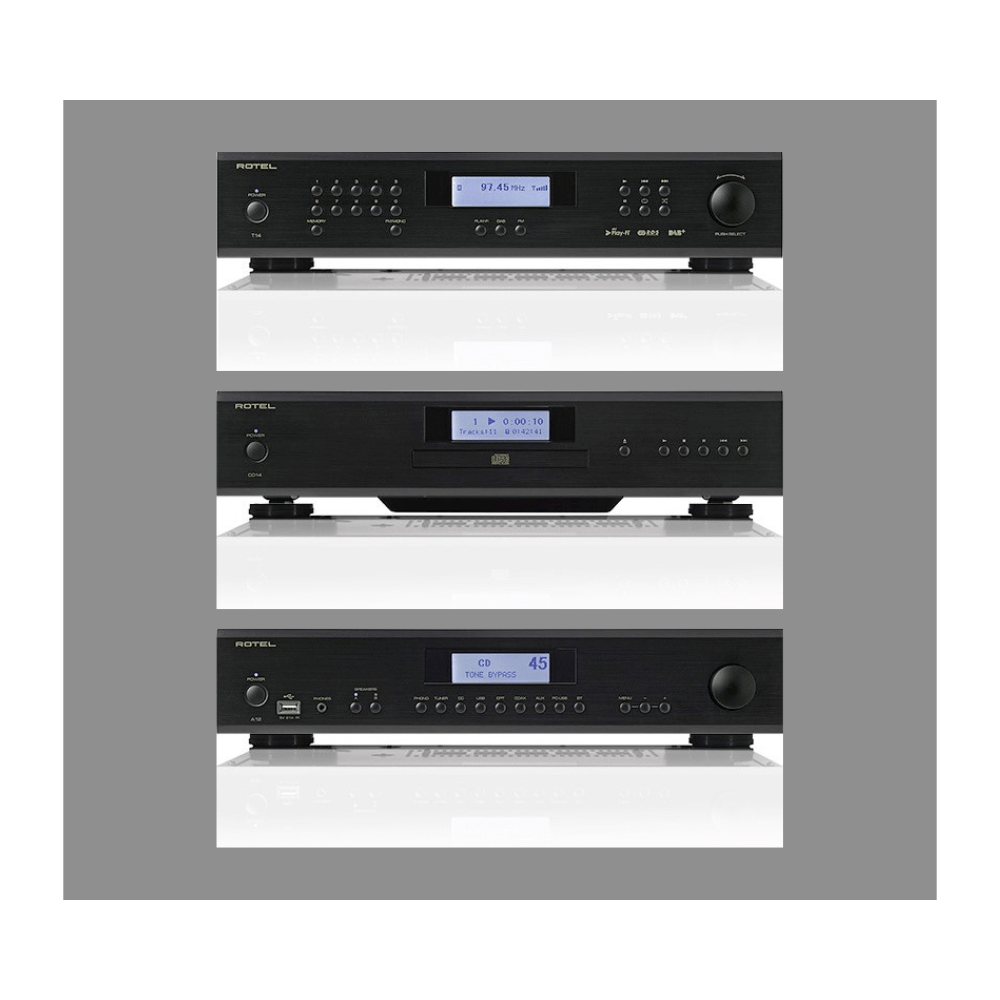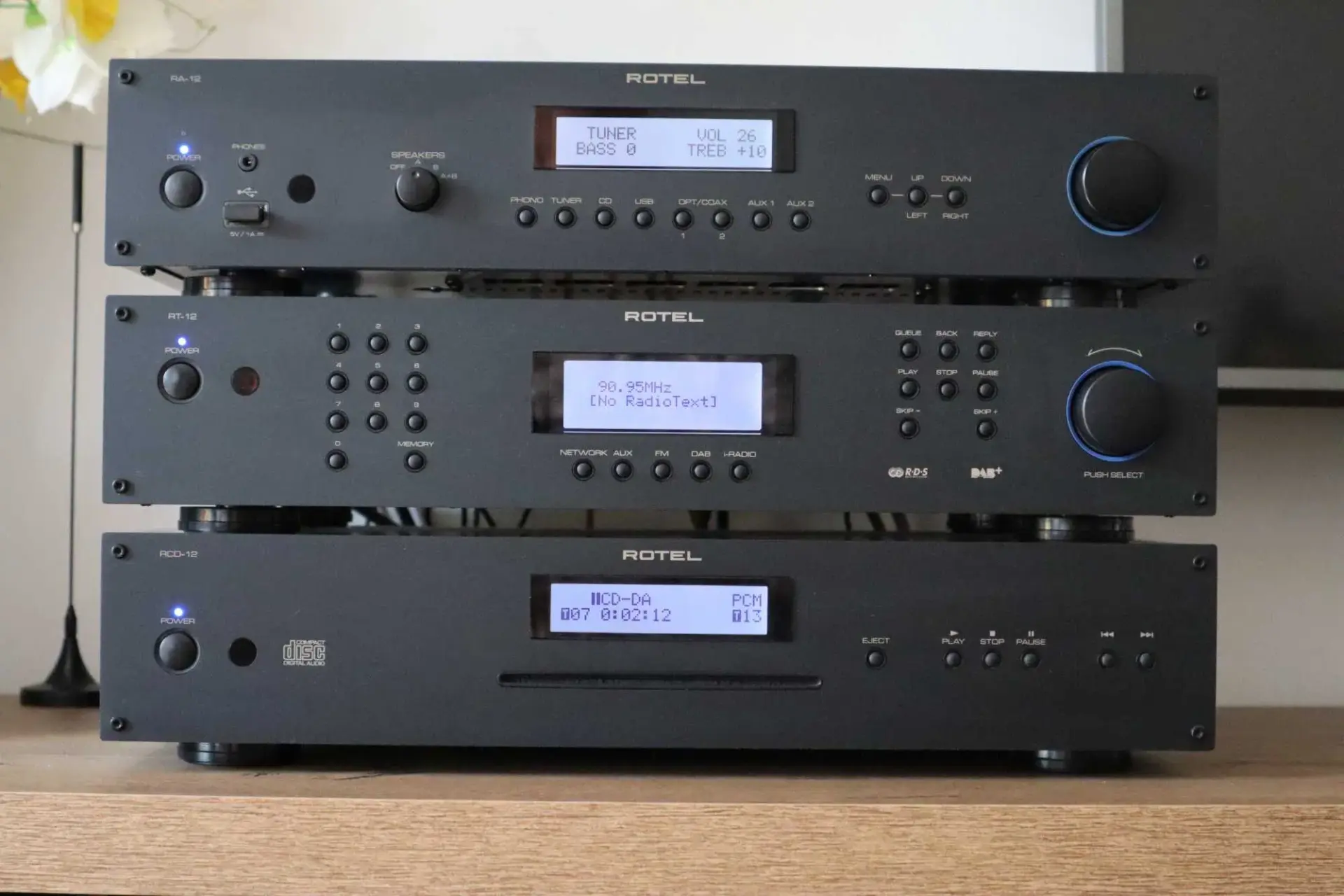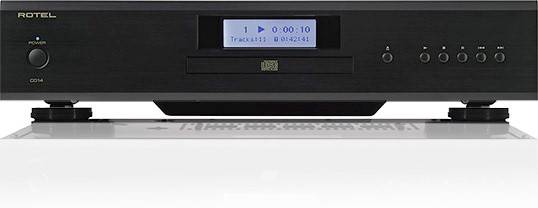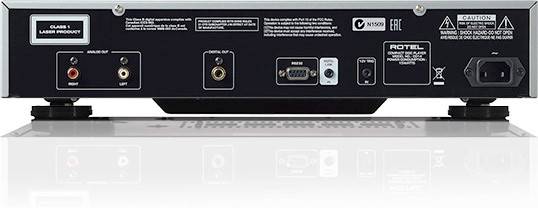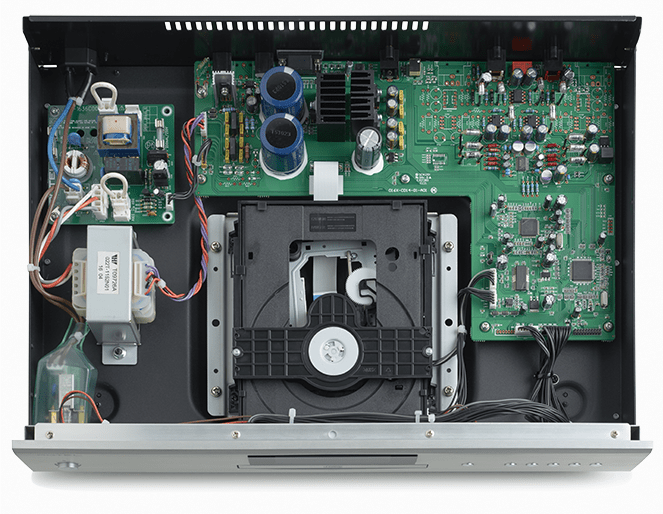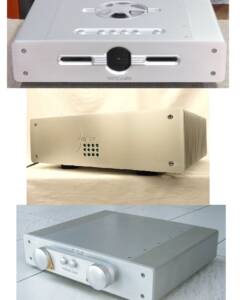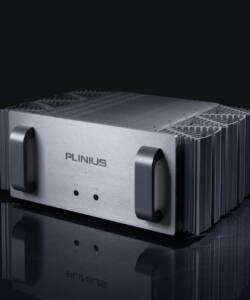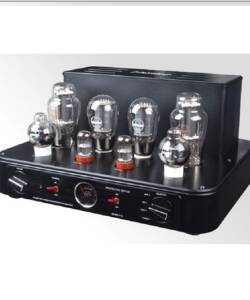Rotel A12 Amp, CD14 CD Player, T14 Network Tuner
Original price was: R78,000.00.R28,500.00Current price is: R28,500.00.
On paper, the Rotel RA-12 seems a lot like the Award-winning RA-10 (£350), with the addition of a built-in DAC, Bluetooth connectivity, and increased 60W per channel output. But switch it on and its character is subtly different.
Rotel RA-12 review: Performance
Like its little brother, the RA-12 is evenly balanced, reaching satisfyingly deep into bass, while the midrange is articulate and controlled. It shares a similar tonal balance with the RA-10, along with a good dose of detail and precision, but it doesn’t have the dynamic thrust and crisp rhythmic ability that makes the cheaper amp so engaging.
You’d expect the £600 RA-12 to surpass the strengths of its budget sibling, but play Amanda Palmer’s Runs In The Family via the analogue inputs and it isn’t fully expressive of her attitude-laden vocals.

The RA-12’s soundfield could have a touch more depth and openness, and the mellow glow that we loved so much in the RA-10’s phono stage isn’t as forthcoming here.
Switch to the digital inputs (there are two optical and two coaxial sockets) and the results are broadly consistent, but the sound is slightly brighter, which adds a touch of sparkle. The line-level connections offer a much richer listening experience, albeit a restrained one.
Rotel RA-12 review: Features
In addition to the four digital inputs, the Rotel has five line-level inputs (including moving magnet phono), two sets of speaker outputs and preamp outs.
There’s also a mini-USB socket round the back, but before you get all excited about this providing a computer audio hook-up, hold your horses – it’s there only for future firmware upgrades.
Speaking of digitally-stored music, also worth noting that while the front-panel input can accept content on memory devices, its capability is somewhat limited: it’ll only accept AAC(m4a), MP3, WAV and WMA (up to 48K 16 bit).
So if you want to play FLAC or Apple Lossless files off a memory stick, as we did at the launch of the 12-Series products down at Rotel distributor B&W in Worthing a while back, you’ll be scuppered.
However, the built-in Wolfson WM8740 DAC supports files up to 24-bit/192kHz via the conventional digital inputs, so higher-resolution files could be played into it via a computer with a digital output, or one combined with a suitable USB-to-S/PDIF interface.
That front USB also allows Bluetooth connectivity, using a dongle included with the amplifier. It’s not as elegant as an ‘under-the-hood’ Bluetooth implementation, agreed, but it does the job.
Other connectivity extends to two 12V trigger outputs to control external equipment, while there’s also a Rotel Link socket, enabling the RT-12 ‘Digital Gateway’ to control the amp via a 3.5m-plug-terminate cable.
There’s also a headphone socket on the front, along with a prominent display, and the Rotel is supplied complete with the company’s RR-AX91 remote handset, which can also ‘drive’ basic functions of the company’s CD players and tuners.
Using the display and the remote, it’s possible to adjust and store the bass, treble and balance, and set up the volume level at which the amplifier fires up from standby.
It’s also possible to dim the display in seven steps, and determine how the amp connects to a CD player in a complete 12-Series system, using the Rotel Link CD function: you can choose ‘CD’, which uses the analogue connection, or ‘CX1’ or ‘CX2’, which select the respective coaxial digital inputs.
Rotel RA-12 review: Build
As is usual for Rotel components, the RA-12 is built around carefully selected and custom-made components.
The power transformer (above) is of a custom design, engineered and manufactured in-house as part of a low-impedance supply with generous reserves, and signal paths are kept short and symmetrical in the quest for the purest possible signal.
There’s also extensive protection against overheating or short-circuiting of the speaker outputs: this will illuminate a front-panel LED should it ever be triggered, as well as shutting down the amp. However, this protection is kept independent of the audio signal, working by monitoring the temperature of the output devices.
For the same reason, the amplifier comes out of the box with its tone controls bypassed, as is indicated on the front panel display. To use the tone controls via the menu system, you first have to deselect this bypass.
Finally, even the headphone implementation is designed to keep it out of the sonic equation, as is usual with Rotel amplifiers: inserting a headphone plug won’t shut off the speaker outputs, and you need to turn the speaker selector to ‘off’ for private listening.
Rotel RA-12 review: Verdict
The exhaustive features are a great point in the RA-12’s favour, and there’s enough going on sonically to keep you listening. It isn’t a true star at this price level, but remains worthy of consideration if you crave an amp with such a well-packed bag of tricks.

Stop me if I’m being presumptuous but I suspect that most of the readers of this august journal can remember a time when the only way to listen to music without paying for it was on the radio. And, if you were listening in the UK, that was a very confined experience where the few broadcasters on FM were only interested in a mainstream audience. There were some stations that broke through the top 40 playlist barriers, like Radio Caroline and Radio Luxembourg on AM, and those prepared to stay up late enough could enjoy a genuinely eclectic mix on the John Peel show on BBC Radio One. But if you missed it that was it, there was no ‘listen again’, no music on demand, and definitely no Spotify, YouTube, or Tidal. All of which meant that the radio held rather higher status in the hierarchy of audio sources than it does today – an age when FM tuner sales were in free-fall, even before the threat to turn off analogue broadcasting came up again.
Radio still has its place for me. I frequently listen to specific shows in the hope of hearing something new and interesting (I have a Tidal account but that’s of little use unless you know what to look for or are a hip hop enthusiast). Rotel is hoping I’m not alone in thinking that, and there’s an audience for an all-singing, all-dancing multi-source ‘wireless’; a single device that can receive the majority of broadcasts and internet streams on the major platforms and more. The Rotel T14 is an FM and DAB receiver and a network streamer with access to internet radio and various streaming services, I don’t think there are many source components that provide the range of options than the T14 does. The back panel says it all, with a coaxial socket for an FM aerial, threaded coax for DAB, and twin Wi-Fi antenna for network streaming. It’s a little odd that there’s no RJ45 for a direct Ethernet connection to a network, but wires are clearly out of fashion these days. Of course, you still need wires to go to the supplied DAB and FM aerials, however the latter is redundant unless you’re living in the right place. I wasn’t initially able to get a clear signal from the T-shaped indoor antenna supplied and resorted to the DAB feed instead.
The DAB antenna has a magnetic base and when placed on a suitably ferrous bit of casework gets a stronger signal than otherwise, again this will be location specific and best results will be achieved with an external antenna, but who has one of those these days? I was able to pick up a good if not comprehensive range of DAB stations using the ‘national scan’ option, it found all the BBC stations but not Classic Rock (now on the Absolute roster). It’s fairly easy to stick your preferred stations into the preset buttons on the fascia or remote for ease of access and the nature of the input suggests you can have more than 10.
When you start to look at the internet radio options, it makes the array of DAB broadcasters seem very limited, I guess that it didn’t cost a lot more to include the terrestrial radio options on the T14 and there will always be times when the broadband is on the blink, but otherwise the net is hard to beat. For a start you can search for stations by name, albeit not always with success; for example, it found BBC Radio 3, but not Fluid, which in its ambient genre listing. You can search by location and city, which is fine if you know which city your station is coming from, but most net radios have station lists for countries. There are also podcasts listed by genre; this has Marc Maron’s WTF but not Adam Buxton’s popular show, popular in my household at least.
The network streaming side of the T14 is controlled by the DTS Play-Fi app, but can only be used once you have managed to get the unit onto your network, a process that proved slightly more tricky than usual, but at least didn’t involve inputting a password via the buttons on the fascia. The App is a little mystifying at times; getting back from the one of the streaming platforms or internet radio to the main menu confounded me for a while, but did prove possible. There is a stack of music services available, more than any other streamer I’ve tried, including favourites like Tidal, Qobuz, and Spotify Connect alongside Deezer, Amazon Music, Napster, and Pandora. Some of these are region specific of course and there’s more than a clue to the T14’s target market in that list.
Quite a lot of operations can be done with the front panel buttons, but hard as I looked I couldn’t find a seek button for FM stations. The manual suggests two methods for doing this, both of which proved reviewer-proof. However, I did note that reception had improved for Radio 3 on this occasion; it wasn’t noise free but gave the impression that a slightly better or better placed aerial would deliver decent results. Sound quality with the same station on DAB is reasonably open with some stereo solidity; it seemed a little lacking in fine detail, but given the compression used by broadcasters, even of BBC R3’s calibre, that’s hardly surprising. More importantly it made some Schoenberg sound remarkably musical and listenable – some very teenage, easy-listening Schoenberg that is; the Second Viennese School isn’t exactly on heavy rotation chez-Kennedy. Switching to the same station’s net stream produced a small reduction in quality, the DAB option being slightly cleaner and more open, but it’s a close call and switching to Play-Fi sources is not terribly quick.

That said, when you are streaming, those buttons on the right-hand side of the display can be useful. Rarely have I seen so many interwebular control options in metal; usually you have to resort to a remote or control app to skip tracks, shuffle, or repeat. Using the T14 as a network streamer with an Innuos Zenith SE server results in a somewhat vague sound by the standards of a good (wired) streamer. Whether this is due to the wireless connection or the streamer and DAC in the Rotel is hard to say, but the fact that it is also a tuner may be a factor – RF noise being the enemy of digital audio. It’s not an offensive sound but neither does it make you want to pay attention, which is a pity when there’s a server of the Zenith’s class feeding it. With Tidal the result is a little weaker than a wired streamer but the difference isn’t as marked, presumably because the signal has already travelled a fair way, and I had a lot of fun listening to a variety of different songs.
Going back to the server feed I tried a number of pieces starting with Beethoven’s ‘smash hit’ the 5th Symphony [Barenboim, Beethoven For All, 24/96, Decca], this had plenty of scale and a good helping of the drama that makes it so diverting, but the sound lacked clarity and imaging was rather vague. None of which stops you enjoying it of course but a good streamer is capable of showing the timing and dynamic subtleties that fail to come through clearly on the T14. Simpler material such as Radiohead’s ‘Decks Dark’ [A Moon Shaped Pool, XL] fares much better; its clearly defined, percussive nature comes through well even if the finer aspects of the imagery are left to the imagination. I think the Rotel’s main problem, however, is timing; the bass line on Patricia Barber’s ‘Touch of Trash’ [Modern Cool, Premonition] sounds slow, limiting the extent to which the music can connect with the listener. Removing the DAB and FM aerials did seem to help a little, but that undermines the point of the product.
There is a digital output on the T14 too, so I gave that a whirl with a rather OTT (under the circumstances) DAC in the form of a Chord DAVE, and this clearly helped. It brought refinement and clarity that made Joni Mitchell’s Court and Spark[Asylum] a joy once more, with decent definition across the board and improved if not quite kick ass timing.

The Rotel T14 is a useful piece of kit if you want to kill two birds with one stone without going down the AV receiver route. Whether it makes sense to incorporate a tuner into a product that can find the same programme, and a lot more, online is another question. It’s a niche product no doubt, but one for which there could well be a market if enough of us radio lovers still want a decent source.

As Rotel has been manufacturing hi-fi gear for over 55 years, it’s surprising I’d never heard any of its components. The 14 Series gear reviewed here falls towards the entry level of the Rotel line. In today’s market, however, that doesn’t mean it’s stripped of extras. The A14 amplifier in particular is chock full of features—it has a moving-magnet phonostage, a very capable DAC that can play DSD and PCM music files, an aptX Bluetooth connection, a front-panel USB connection so you can play the music stored on your smartphone, and a headphone amplifier to listen to through your favorite cans. Rated at 80 Class AB watts per channel, the A14 sells for $1299. The $599 CD14 CD player follows the example of many recent CD players—it doesn’t try to be anything other than a CD player. Actually, I probably shouldn’t have said “many” CD players, since there aren’t “many” CD players on the market. I have no data to support this, but I’d venture a guess that there are far more turntables than CD players in current production. But if you need a DAC to use with a music player, there’s one in the A14. Since these two Rotel components are part of the same family and look alike, I’ll review them together. When connected together via Rotel’s proprietary Rotel Link, they can be controlled by an app on your iPhone. Each unit comes with its own remote control, as well. As parts of the 14 Series, they share the same styling—simple black or silver faceplates slightly beveled at the top and bottom with a small display window in the center.
Hard to believe, but we get a few letters and e-mails griping about the prices of high-end components, and it’s true—some are quite pricey. But you don’t have to pay a fortune to get acceptable sound; budget gear is better than ever. These units, especially the A14 amplifier, exemplify how good budget can be. And if the A14 is above your financial comfort zone, there’s also a the very similar A12 amplifier for $899 with a less advanced DAC and “only” 60Wpc—not much to give up for $400 savings.
It’s actually easier to list the features the A14 lacks than the ones it has. It has no moving-coil phono input (the phonostage’s gain is suitable for moving-magnet cartridges only), but I doubt that most people who buy an amplifier like the A14 will invest in expensive moving-coil cartridges, and even if they do, a step-up transformer or headamp can add support for moving coils. The A14’s power output should suffice to drive quite a few speakers, but if you need more power, there are preamp outputs on the rear of the amp that could be used with an amplifier like Rotel’s massive 350Wpc RB-1590. There are plenty of analog inputs and enough digital inputs for almost any digital source you’re likely to use. So you’re giving up very few options at the A14’s price. Of course, this assumes everything works fine, a subject that this review will explore.
I’ve heard several industry pundits proclaim that the CD is a dead or dying format, but that’s baloney; many new recordings are still released on CD, and there are tons of used CDs available—just check eBay, or your local used bookstore. Lots of audiophiles and music lovers already have large CD collections, so saying the CD is dead makes as much sense as saying the LP is dead.
The CD14 uses a highly regarded Wolfson DAC chip, which is capable of sampling rates up to 192kHz. Of course, as the sampling rate of CDs is 44.1kHz, the DAC’s capability is overkill. The CD14 will also play MP3 files, but you’d need to burn those onto CDs first (there’s no USB input that would allow you to play them off a USB flash drive). Analog output is on unbalanced RCA jacks—there’s no balanced XLR out. Front panel layout is pretty standard: a power on/off button on the left side, a slide-out CD drawer underneath a digital display window in the center, and standard operational buttons on the right. The remote control duplicates the button functions, and more. On the rear panel, the RCA output jacks are on the left side; the 12-volt trigger jacks and the Rotel Link jacks are in the center, along with a digital SPDIF output on an RCA jack. On the right side of the rear panel is the connector for the power cord, which uses no ground connector. (Though IEC-terminated power cords will fit the socket, the ground wire won’t be connected.) The SPDIF output lets you connect the CD14 to the A14’s SPDIF input or to any DAC with a SPDIF input, and bypass the CD14’s internal DAC. Would that sound better? We’ll find out.
The A14 amplifier’s internal DAC uses an AKM DAC chip to play PCM files up to 384/32 and DSD256 files. However, there’s no MQA capability, and with Tidal now streaming MQA files, that’s become more important.
But wait, there’s more. By pressing the Menu button, you can access bass and treble controls, a balance control, and a dimmer control for the display window. Analog inputs for the mm phono section, CD, tuner, and aux are so labeled on the back of the amplifier, and also on the selector buttons on the front panel. Then there are the digital inputs: two sets of SPDIF inputs (both coaxial), two more on optical (TosLink), a USB Type B, and a Bluetooth. There’s also a front-panel USB Type A connector where you can plug in your iOS Apple smartphone or tablet. You can select each analog and digital input by pressing buttons on the front panel and on the remote—much nicer than having to scroll through the entire list of inputs as you have to do on some preamplifiers. Direct access to inputs is also available on the remote control. There are two sets of speaker output terminals, which you could use to biwire a speaker or drive speakers in two zones.
Setting Up and Using the CD14 and A14
The first things you’ll notice when you unpack the shipping boxes are huge “Getting Started” instruction sheets, almost as large as the boxes themselves. It’s pretty hard to ignore or lose such instructions, which have good illustrated directions for installing the equipment. Inside the box is something you don’t often see: a complete assortment of cables needed to operate the units—power cords, RCA cables, SPDIF cable, USB cable, Rotel Link cable, and 12-volt trigger cables. These are not audiophile-grade wires but are still plenty good enough to get started. There’s also a CD with each unit, which has the Windows driver for the A14, and the full manuals for both devices in PDF format. The CD14 comes with a remote, as does the A14.
Since it’s doubtful lots of users would immediately run out and buy new power cords and RCA interconnects for units priced like the A14 and CD14, I used the supplied cables.
A photo on the Rotel website shows a CD14 stacked on top of an A14. That looks good, and the big, soft feet used on both units should protect whatever they sit on, but I’m not keen on stacking anything on top of an amplifier, which needs ventilation space—the A14 manual says four inches on all sides. Stacking the units would put the CD14’s CD drive right above the A14’s heat sink, which radiates heat. To make matters worse, there’s a section of the CD14 that hangs down below the rest of the enclosure. Located in the center, beneath the drawer, it provides space for the laser assembly that reads CDs. As you definitely don’t want to heat that section up, don’t put the CD14 atop the A14—or any other amplifier.
After you install the batteries in the remote and cable up the CD14, you’re ready to listen. When you pop in a CD, you’ll see its status in the front window displayed with black letters on a white background. However, the display is rather small, so you may need a magnifying glass to read the smallest text. The large black plastic CD14 remote is well designed and easy to use, with a numeric keypad that enables you to jump directly to any track on a CD rather than having to scroll through them one at a time. Some of the lettering on the remote appears in grey, which is a bit hard to read on the black background. Most functions on the CD14 remote are repeated on the A14 remote, so you can use the A14 remote to control both machines. (If your coffee table suffers from remote control overload, that’s a valuable feature.) The CD drawer can be operated either from the remote or the front panel. The only quibble I had with the CD14’s operation was with taking CDs from the drawer; it was hard to remove them since the usual indentations were not cut out on the sides of the tray. I had to either reach underneath the drawer and poke the disc upward from below, or stick my little finger into the center hole from above to lift the disc that way—both methods were annoying.
The Rotel Link cable that connects the A14 to the CD14 is the one with the stereo mini-plug and white connectors. That’s spelled out in the A14 manual but not the CD14 manual. If you use the Rotel Link, don’t use the 12V trigger connection (the cable with the mono mini-plug and black connectors).
The A14 should be broken in from “two to four weeks of listening enjoyment” per Rotel’s Tech Support. I wasn’t sure what “weeks of listening enjoyment” meant, so I gave it three weeks of 24/7 break-in. Incidentally, Rotel Tech Support’s Tim Wyatt was very prompt and helpful in responding to my questions, which should be the norm but isn’t always.
I connected my KEF LS50 speakers using Wireworld Helicon OCC speaker cables. The KEFs are small stand-mounted speakers with a low 85dB sensitivity and limited bass response. Above the bass region, their response is fairly flat, certainly not peaky by any stretch of the imagination. I normally augment them with a subwoofer, but of course using subwoofers or other forms of powered woofers when testing an amplifier is verboten, since you’re listening to the subwoofer amplifier in the bass, not the amplifier you’re reviewing. This is not a quibble so much as an observation. The volume level for the A14 had to be set at what appeared to be a very high numeric level (between 60 and 70, with 96 being the maximum) to achieve my normal listening volume, and I’m no head-banger. There was still plenty of headroom left, so it’s just a matter of convention what level is shown on the front panel. At least the numeric volume level is displayed in a large font, easy to see from my listening chair.
I wanted to get the best sound from the digital inputs of the A14, so in addition to the CD14, I connected my SOtM network music player as an external source. That way, I could explore the A14’s ability to play high-resolution PCM and DSD files. Hint: When you’re using a source that has a USB output, select the PC-USB input on the A14, not the USB input. The USB input refers to the USB connector on the front panel, where you can plug in your smartphone.
To check out the A14’s phono input, I connected my turntable to the A14—not directly, though. Since I have a moving-coil cartridge, I used a Rothwell Headspace headamp to boost the cartridge output to a level that the A14’s moving-magnet phonostage could handle. (If you’re not familiar with a headamp, think of it as an amplifier that performs the same duties as a step-up transformer, boosting the signal level of an mc cartridge to that of a mm cartridge, but not applying RIAA playback equalization.)
Some of the files I use for component evaluation are high-resolution, so to evaluate the CD14, I converted a few of them to 44.1kHz sampling rate/16-bit WAV files and then burned them to a CD-R. I prefer black CD-R blank CDs, which may reduce scatter of the laser beam. Some CD players won’t read these, but the CD14 read them without a hiccup. I also used these converted files to test the Bluetooth connection. Both the CD14 remote and the A14 remote have numeric pads that let you access a track directly; without this feature you must advance through tracks manually to reach the one you want to hear—a real pain when your CD has lots of tracks.
To check out the headphone input, I plugged my HiFiMan HE-400s into the front panel jack. These planar-magnetic headphones are moderately low in sensitivity, and usually need a fairly hefty amp. I needed an adaptor to fit the ¼” plug into the 3.5-mm jack in the front panel of the A14. When I plugged in the ’phones, the speaker output did not cut off, so I had to turn off the speakers via the front panel. The A14’s internal headphone amp had plenty of power to drive the HiFiMans, and sounded very good doing so. If you’re a serious headphone listener, you’ll want a separate headphone amplifier, but the A14 is good for occasional headphone use.
Balance and tone controls were once commonplace, but lately have almost disappeared from the hi-fi scene. Now they’re making a comeback in integrated amplifiers. On the A14, these controls are accessible either through the menu or from the remote control. The remote control is really the only useful way to access the tone controls. First you have to press the bypass button to engage the tone controls (normally they are bypassed). The bass and treble controls both work as you would expect, with fairly gradual action in their respective regions. The balance control is also accessible through the remote control, and is always engaged. This system works and minimizes the number of controls on the front panel, but for serious use it isn’t as handy as actual knobs on the front panel. However, if you don’t need or want to use these controls, you’d probably rather they didn’t clutter up the faceplate.
Sound
For a variety of reasons I do most of my listening these days to digital music streamed from a central NAS drive over my home network and rendered by a network music player, either a laptop computer running a program like Roon or JRiver Media Center or a dedicated music player like the SOtM sMS-1000SQ, converted to an analog signal by a DAC. Control of my music playback is through the appropriate app installed on my iPad. Although I have a lot of ripped CDs, I also listen to many downloaded high-resolution files. To establish a familiar benchmark for comparison, I started listening to digital music, using the SOtM network music player connected to the A14’s internal DAC via its PC-USB input. (I’m using a limited number of musical selections in this review since we need to evaluate the A14’s many inputs.)
“Folia Rodrigo Martinez” from the album La Folia 1490-1701 was ripped from the CD Alia Vox AFA 9805 as an AIFF file. Played by Jordi Savall and a small band of Renaissance music specialists, it’s a lively, energetic piece. Most Renaissance music doesn’t have much bass, but this piece has a drum that extends into the mid-20Hz range. Of course, the tiny KEF speakers can’t begin to play that low, but driven by the A14 they actually surprised me with how much upper-bass impact they had. They also captured percussionist Pedro Estevan’s very light brushes of his sticks on the drum—something that often disappears beneath the noise floor. Throughout the piece, the many percussion effects were plainly audible, more so than with many more expensive components. What was not done as well was the reproduction of Savall’s viola da gamba—a cello-like instrument from the Renaissance and Baroque eras. The viola da gamba plays the main tune, but unfortunately it was slightly muffled, without the harmonic richness that’s a part of this recording.
The Tallis Scholars’ “Miserere” from their album Allegri’s Miserere & Palestrina’s Missa Papae Marcelli is a 96/24 FLAC file. “Misere” is an a capella work, with a small choral group in the front, a solo tenor narrator, and a small solo group at some distance behind the main group. The A14 projected the piece with a huge soundstage; when the solo group behind the main group entered, the rear of the soundstage was illuminated more brightly than I’ve heard it before. The solo tenor was portrayed without any brittleness, a trait I sometimes hear from lesser components. His vocal shadings were quite expressive, including the barely detectable vibrato he uses at times. The echo of the solo group was realistically integrated into the overall soundstage about as well as I’ve heard it. The A14 widely spread the soundstage between the speakers, with the solo tenor firmly positioned in the center.
Shelby Lynne’s album Just a Little Lovin’ is a DSD64/DSF recording sourced from Acoustic Sounds. The title song was reproduced with excellent detail across the frequency spectrum. The A14 captured delicate inflections of Lynne’s voice, so that I could easily understand her phrasing as she strove to project meaning and emotion. Although the KEF speakers don’t go too deeply into the bass, the A14 made the LS50s sound like much larger speakers, projecting lots of punch and impact that almost made me forget there’s a lot of deeper bass in this song. The A14 was particularly good at reproducing percussion; at one point, the percussionist taps a cymbal very lightly, and the A14 reproduced the barely audible cymbal ever so convincingly. It was all there—the initial transient as the cymbal was struck, the sustain, and the decay as it gradually faded into inaudibility. This track, recorded at a low level, needed a volume setting of 81 to achieve normal playback level, leaving plenty of headroom. OK, so that’s our benchmark for these pieces, let’s see how they sound through other inputs.
A configuration I imagine will be popular with many readers would be the combination of the CD14 driving the A14. So I popped the test CD-R into the CD14 and started listening, first with the CD14’s internal DAC. This is what you’d hear if you buy the CD14 to use with an amplifier that lacks an internal DAC.
“Just a Little Lovin’” lacked all the bass impact and slam I’ve heard from the high-resolution file. Lynne’s vocals were mostly smooth and breathy, but, a couple of times, had a very slightly edgy sound.
On “Miserere” I heard more of this edginess when the main choral group sang. I had expected to hear it, if at all, when the solo tenor entered, but his part was clean as a whistle. The solo group was imaged at a greater distance behind the main group and the reverberant echo that occurs when they sing was more smeared. The soundstage was not as well defined as it was with the high-resolution file.
On “Folia Rodrigo Martinez” I again heard a slight edginess, and the bass had less impact than the original file.
Next, I switched to the DAC in the A14, connected to the SPDIF coaxial output from the CD14. In this configuration, I used the CD14 as a transport, connected via the digital output to the A14. I played the same CD.
On “Folia Rodrigo Martinez” the first thing I noticed was an increase in bass impact over the CD14 with its internal DAC. Then I noticed there was less edginess. Finally, I noticed that the piece sounded more open and spacious than the CD14 with its internal DAC.
Switching to “Miserere” the story was similar: less edginess for the main choral group, noticeably less smear in the reverberant echo when the distant solo group sang, and an overall more open soundstage, though not as well defined as on the high-resolution file.
On “Just a Little Lovin’” the bass descended deeper, though not as deeply as heard with the high-resolution file playback. There was a smidgen of the edginess left, but less than with the CD14 by itself. Percussion instruments were still realistically reproduced. I think these results tell us the DAC in the A14 sounds better than the one in the CD14.
Finally, I listened to files played from my laptop computer through the Bluetooth connection. I used the JRiver playback software, and instead of installing a driver for the DAC I installed a Bluetooth driver. The A14 then paired with that setup easily. Since Bluetooth wouldn’t support high-resolution files, I converted the files to CD-quality WAV files using the dBpoweramp music-converter program.
On “Folia Rodrigo Martinez” I was surprised at the high quality of the sound. Previous experiences with Bluetooth playback using other components have left me unimpressed. But I heard very respectable sound quality from the Bluetooth connection, so much so that I wondered if part of my previous unfavorable impressions had stemmed from using an iPhone to play music. Could the use of the high-end JRiver software have made that much of an improvement? I heard powerful, impactful bass, as deep as any other source. Instrumental harmonics were accurately portrayed, and dynamics were accurately tracked. A very good experience.
Then I switched to “Miserere.” As much as I’d like to report an equally good listening experience, I can’t. Vocals sounded very slightly rough—first the main choral group, then the solo tenor. The solo group behind the main group sounded unfocused, and the reverberant echo was a bit smeared.
Wanting to hear another vocalist, I played “Just a Little Lovin’” and again heard a bit of roughness. As before, bass reproduction was quite respectable, and the instrumentals were fairly realistic, but once again Lynne’s voice had an unfortunate edge or roughness. So I think Bluetooth has a way to go yet before it’s equal to wired connections, though I was still amazed at how far it’s come in the couple of years since I first tried it.
I also wanted to try the A14’s mm phono section, but unfortunately, a couple of the evaluation tracks had no equivalent LPs; however, Shelby Lynne’s Just a Little Lovin’ did, so, of course, I used it. It exhibited the smooth, continuous sound typical of an LP, but also had a few pops and clicks, also typical of LPs. Although the bass did not extend as deeply as with the DSD version, it somehow sounded more realistic; although it’s exciting, the digital recording probably overdoes the bass. The LP’s bass seemed better integrated into the midrange. Microdynamics seemed to pop with a bit more energy. Lynne’s vocals benefited from the analog smoothness.
Next I played a recording by the Emerson Quartet augmented by Mstislav Rostropivich of Schubert’s String Quintet in C (Deutsche Grammophon Stereo 00289 479 4384) to get a feel for how the A14 handled a small instrumental group. The string sound was very smooth and continuous, harmonics were rich and accurate, and microdynamics were just right.
I’m not so sure I really determined how the phono input sounded so much as how LPs sound compared to digital. That said, I thought the phono section sounded deliciously expressive.
Comparison
I don’t have anything available remotely similar to the A14, so going on memory I tried to compare it to the Yamaha A-S801 integrated amp I reviewed in Issue 263. The Yamaha was physically larger than the A14 and generated 100Wpc. Like the A14, it had an mm phono section and an advanced DAC. I used it with Yamaha’s YBA-11 Bluetooth wireless adaptor, which gave it Bluetooth capability similar to the A14. Like the A14, the Yamaha had a built-in headphone amp, and similar features such as tone controls and a balance control; additionally, it had a loudness control, useful for maintaining frequency extension when listening at low volume levels. It also had direct connections for a CD player, bypassing all those features. But unlike the A14, which has all its features accessible through the menu, the Yamaha had separate knobs for each of those functions—which I found easier to access than a menu. And it only cost $899, $400 less than the A14—almost 30% less, for 100Wpc. I used only file-based playback to evaluate the Yamaha.
On “Folia Rodrigo Martinez” the Yamaha exhibited similar bass performance, but didn’t quite capture the very light taps on the drum as well as the A14. The percussion instruments blurred into the background more than on the A14, but the viola da gamba was clearer on the Yamaha.
On “Miserere” the Yamaha was similarly free of brittleness, but the A14 was noticeably better at depicting the soundstage of this piece. On the A14, the small solo group behind the main group was reproduced with less smear in the reverberant echo. The Rotel’s soundstaging was way above the norm.
“Just a Little Lovin’” saw the Yamaha produce an equal amount of detail and bass impact, but the A14 was a bit better at reproducing the delicate cymbal. The extra power of the Yamaha could be useful if you used it with less sensitive speakers, but both drove the KEF speakers easily. My memory of the Yamaha’s sound is that it was more matter-of-fact than the A14’s, which was delightfully tuneful.
Bottom Line
Rotel’s CD14 CD player and A14 integrated amplifier show us that Rotel still deserves its reputation for affordable high-quality audio equipment. In these days when lots of manufacturers are talking about building their “last CD player,” the CD14 is a fine performer at a modest price. Sounding good as a stand-alone unit, it showed even more promise as a CD transport. Because many integrated amplifiers now include high-quality DAC circuitry, using the CD player as a transport is a good way to step up the player’s sound quality—just plug its digital output into the SPDIF input of the integrated. Rotel even supplies the SPDIF cable.
I was hugely pleased with the A14 integrated amplifier. One of the crop of modern integrated amplifiers with a very capable internal DAC and Bluetooth connectivity, it’s ready to support virtually any source you might choose, even an mm phono cartridge, which sounded utterly delightful. With power a-plenty to drive most of the speakers you’d likely partner to, it’s a superb choice for a modest audio system, whether for a beginner, an office, or a bedroom, or even for a main audio system. While I appreciated its long list of features, what really impressed me the first time I heard it was its sweet, musical sound which encouraged long listening sessions. Highly recommended.
Description
ROTEL RA12 Integrated Amp
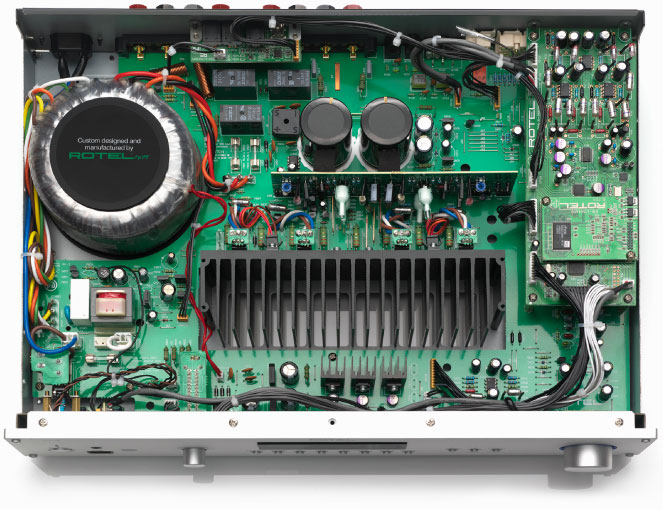
17″ × 3.6″ × 13.5″
ROTEL T14 Tuner/STREAMER
This is not your father’s tuner. While the T14 can receive classic analogue FM stations, it has also been designed to take advantage of Digital Audio Broadcasts (DAB+), as well as all popular Internet streaming services. That’s a lot of options, but Rotel’s T14 makes selecting them as simple as the touch of a button. The 30 FM and DAB+ presets provide easy access to all of your favourite music stations.
A near endless supply of music sources are supported by the T14 using the DTS Play-Fi iOS and Android Apps including Spotify, Pandora, Tidal, Rhapsody, Amazon Music, Deezer and more. Your listening options for radio broadcasts have never been more varied or available at such high quality.*
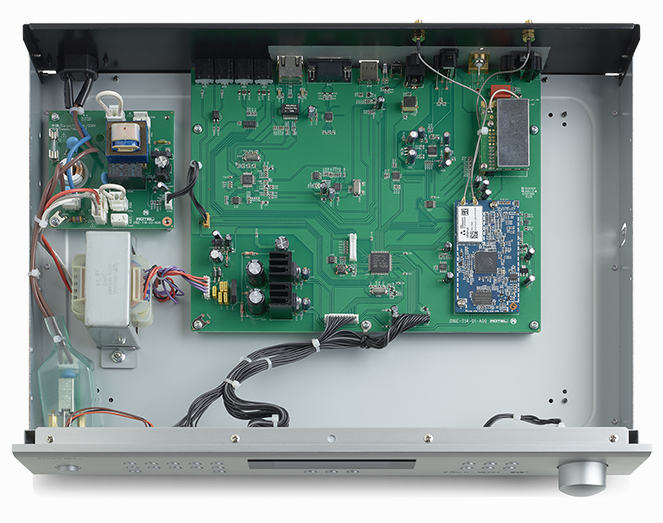
17″ × 3.6″ × 13.1″
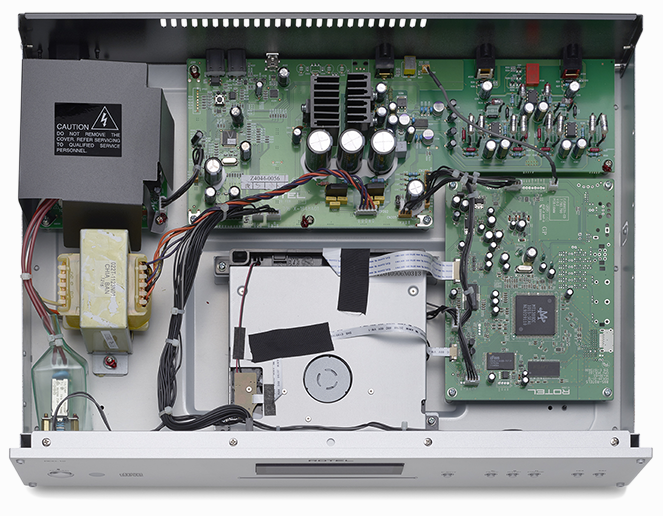
17″ × 2.9″ × 12.3″
